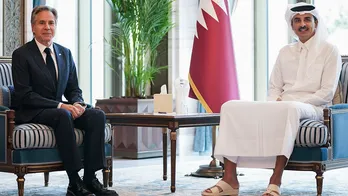The winners from the WHO's short film fest were grim, inspiring and NSFW-ish
Jonathan and his twin brother were born in Sierra Leone with clubfeet. His twin died as a baby, and his parents were told Jonathan may never walk like other children.
His father turned to prayer and his mother to an herbal healer. The family felt hopeless. That is, until a relative heard a radio report about a special clinic, leading the family to travel across the country to get treatment for Jonathan.
That's the true story of Jonathan's Miracle Feet — one of the winners in the World Health Organization's annual Health for All Film Festival.
"It is very symbolic of a situation which is global and which is not only for the African region," says Gilles Reboux, who was the Film Festival Lead overseeing the competition. "I think this film is representing well what we look for in the festival."
The Health for All Film Festival, now in its fourth year, is meant to encourage filmmakers from around the world to use their skills for the purpose of health communication. The short films are all between three and eight minutes long, sorted into several award categories. In each year of the competition, the festival has received over a thousand submissions.
Three "Grand Prix" awards are given in the categories of Universal Health Coverage, Health Emergencies and Better Health and Well-being. Four smaller awards highlight the best films related to climate change and health, sexual and reproductive health, best student film and best very short film. Some of the films are submitted by nonprofit groups. Others are from independent filmmakers.
At the end of Jonathan's Miracle Feet, Jonathan is fully healed, happy and playing soccer with other kids his age. That story of hope and resilience earned the top prize in the Universal Health Coverage category.
The Brazilian film Nurses Facing COVID (Na Lihna de Frente) is the Grand Prix winner in the Health Emergencies category. Nurses in Brazil talk about the brutal conditions in which they were forced to work at the height of the pandemic — long hours in overcrowded hospitals, all while watching patient after patient die.
During the film's most powerful moment, Graça Athayde, who contracted the disease while treating patients, calls her coworkers to tell them she is at home, unable to find treatment, "just waiting for death to come."
Athayde survived. But her story is a potent reminder of the risks faced by frontline health-care workers during the pandemic.
While Jonathan's Miracle Feet and Nurses Facing COVID both finish on a relatively positive note, One in 36 Million: Story of Childhood Lead Poisoning in Bangladesh, ends much more ambiguously.
The Grand Prix winner in the Better Health and Well-being category tells the story of Saim, a third grader who is losing his memory because of lead poisoning. Saim can't remember his letters or what grade he is in – and his mother says his memory has only been getting worse.
"On lead poisoning, we have received several stories this year and during the previous edition [of the festival] as well," says Reboux. "We try in this festival to have positive stories, but unfortunately when we speak about health, there are also sad stories."
Saim's family was living in Bangladesh next to an illegal lead battery recycling facility. The facility was eventually shut down and the lead contamination removed, but Saim and his little brother Shahid were left with the highest blood concentrations of lead in their village, and the whole family is forced to deal with long-term health problems and stigma from others.
When climate change turns violent is the Indian film that won in the Climate Change and Health category; it highlights the little-discussed connections between climate change and gender based violence. In hotter, drier areas, for example, women must travel farther to collect water, exposing them to a higher risk of being attacked.
"Gender-based violence [against women] is one thing that is exacerbated due to climate change," says Vandita Sariya, one of the film's directors. "This video was not made in mind of submitting to a film festival. I made it purely out of my need to create something which addresses these issues."
The film uses a series of infographics and poignant images to illustrate all of the ways climate change ends up hurting women and then seeks to move the conversation forward. "I had a problem with this narrative, which portrayed women solely as victims of climate change," says Sariya. "So the second half of my movie talks about the potential solutions," including increasing representation of women in government and diversifying women's economic opportunities.
Sariya's favorite festival winner was Vulvo and Dynia, an Israeli film that won the special prize in the Sexual and Reproductive Health category. It covers what she says is an often overlooked sexual health issue: the inability to experience pleasure during sex. The film is a graphic dramatization of a young woman learning she has vulvodynia — chronic vaginal pain. (Note: Vulvo and Dynia contains adult content — including partial nudity and some ... unusual imagery of chicken carcasses).
The film's frank approach made an impression on the award committee.
"The symbolic images used by the producer are very strong and surprising images," says Reboux. "In some ways there's also kind of funny aspects of the narration, although the situation is not easy for the main character in the scene."
The final two award winners are Mirrors, which at 3 minutes in length won the prize for best very short film, and "Gasping for life," named best student film. Both focus on how mental health issues can affect people's lives.
Gasping for life is a German animated film portraying a young person's descent into severe depression, partially due to excessive use of screens and social media. It addresses the reconfiguring of our social lives as a consequence of COVID-19 lockdowns and how some people never quite recovered from those changes.
Mirrors is a Swedish film with famous actors engaging in negative self-talk with their literal mirror images. The film looks to destigmatize mental health struggles by showing how mental health struggles affect us all, even the stars. "This is the very depths of cinematography," says Reboux. "[The film is a] great piece of advocacy and also very well produced in terms of aesthetic."
For Vandita Sariya, who wasn't thinking of submitting When climate change turns violent to a festival when she started making it, winning was quite the surprise. "I'm delighted! I definitely did not expect it to happen," she says. "I was looking at all the other movies [on the shortlist] and was like, 'Oh my God, these are such brilliant films.' "
The WHO's Health for All Film Festival is already planning next year's competition, which will begin accepting submissions on Nov. 1.
Disclaimer: The copyright of this article belongs to the original author. Reposting this article is solely for the purpose of information dissemination and does not constitute any investment advice. If there is any infringement, please contact us immediately. We will make corrections or deletions as necessary. Thank you.







